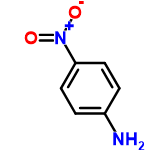4-Nitroaniline C6H6N2O2 structure – Flashcards
Flashcard maker : Julie Noel
Contents
- Experimental Melting Point:
- Experimental Boiling Point:
- Experimental Ionization Potent:
- Experimental Vapor Pressure:
- Experimental LogP:
- Experimental Flash Point:
- Experimental Gravity:
- Experimental Solubility:
- Predicted Melting Point:
- Appearance:
- Stability:
- Toxicity:
- Safety:
- First-Aid:
- Exposure Routes:
- Symptoms:
- Target Organs:
- Incompatibility:
- Personal Protection:
- Exposure Limits:
- Retention Index (Kovats):
- Retention Index (Lee):
- Retention Index (Normal Alkane):

| Molecular Formula | C6H6N2O2 |
| Average mass | 138.124 Da |
| Density | 1.3±0.1 g/cm3 |
| Boiling Point | 333.1±15.0 °C at 760 mmHg |
| Flash Point | 165.0±0.0 °C |
| Molar Refractivity | 37.0±0.3 cm3 |
| Polarizability | 14.7±0.5 10-24cm3 |
| Surface Tension | 60.3±3.0 dyne/cm |
| Molar Volume | 103.6±3.0 cm3 |
- Experimental data
- Predicted – ACD/Labs
- Predicted – EPISuite
- Predicted – ChemAxon
- Predicted – Mcule
- Experimental Physico-chemical Properties
- Predicted Physico-chemical Properties
- Miscellaneous
- Gas Chromatography
Predicted data is generated using the ACD/Labs Percepta Platform – PhysChem Module
| Density: | 1.3±0.1 g/cm3 |
| Boiling Point: | 333.1±15.0 °C at 760 mmHg |
| Vapour Pressure: | 0.0±0.7 mmHg at 25°C |
| Enthalpy of Vaporization: | 57.6±3.0 kJ/mol |
| Flash Point: | 165.0±0.0 °C |
| Index of Refraction: | 1.634 |
| Molar Refractivity: | 37.0±0.3 cm3 |
| #H bond acceptors: | 4 |
| #H bond donors: | 2 |
| #Freely Rotating Bonds: | 1 |
| #Rule of 5 Violations: | 0 |
| ACD/LogP: | 1.39 |
| ACD/LogD (pH 5.5): | 1.31 |
| ACD/BCF (pH 5.5): | 5.80 |
| ACD/KOC (pH 5.5): | 122.42 |
| ACD/LogD (pH 7.4): | 1.31 |
| ACD/BCF (pH 7.4): | 5.80 |
| ACD/KOC (pH 7.4): | 122.42 |
| Polar Surface Area: | 72 Å2 |
| Polarizability: | 14.7±0.5 10-24cm3 |
| Surface Tension: | 60.3±3.0 dyne/cm |
| Molar Volume: | 103.6±3.0 cm3 |
Predicted data is generated using the US Environmental Protection Agency’s EPISuite™
Log Octanol-Water Partition Coef (SRC): Log Kow (KOWWIN v1.67 estimate) = 1.47 Log Kow (Exper. database match) = 1.39 Exper. Ref: Hansch,C et al. (1995) Boiling Pt, Melting Pt, Vapor Pressure Estimations (MPBPWIN v1.42): Boiling Pt (deg C): 272.55 (Adapted Stein & Brown method) Melting Pt (deg C): 71.62 (Mean or Weighted MP) VP(mm Hg,25 deg C): 2.03E-005 (Modified Grain method) MP (exp database): 147 deg C BP (exp database): 332 deg C VP (exp database): 3.20E-06 mm Hg at 25 deg C Subcooled liquid VP: 5.15E-005 mm Hg (25 deg C, exp database VP ) Water Solubility Estimate from Log Kow (WSKOW v1.41): Water Solubility at 25 deg C (mg/L): 5542 log Kow used: 1.39 (expkow database) no-melting pt equation used Water Sol (Exper. database match) = 728 mg/L (30 deg C) Exper. Ref: GROSS,PM & SAYLOR,JH (1931) Water Sol Estimate from Fragments: Wat Sol (v1.01 est) = 1865.9 mg/L Wat Sol (Exper. database match) = 728.00 Exper. Ref: GROSS,PM & SAYLOR,JH (1931) ECOSAR Class Program (ECOSAR v0.99h): Class(es) found: Aromatic Amines Henrys Law Constant (25 deg C) [HENRYWIN v3.10]: Bond Method : 7.51E-009 atm-m3/mole Group Method: 1.81E-008 atm-m3/mole Exper Database: 1.26E-09 atm-m3/mole Henrys LC [VP/WSol estimate using EPI values]: 6.657E-010 atm-m3/mole Log Octanol-Air Partition Coefficient (25 deg C) [KOAWIN v1.10]: Log Kow used: 1.39 (exp database) Log Kaw used: -7.288 (exp database) Log Koa (KOAWIN v1.10 estimate): 8.678 Log Koa (experimental database): None Probability of Rapid Biodegradation (BIOWIN v4.10): Biowin1 (Linear Model) : 0.1430 Biowin2 (Non-Linear Model) : 0.0333 Expert Survey Biodegradation Results: Biowin3 (Ultimate Survey Model): 2.5894 (weeks-months) Biowin4 (Primary Survey Model) : 3.4317 (days-weeks ) MITI Biodegradation Probability: Biowin5 (MITI Linear Model) : -0.0112 Biowin6 (MITI Non-Linear Model): 0.0098 Anaerobic Biodegradation Probability: Biowin7 (Anaerobic Linear Model): -0.0375 Ready Biodegradability Prediction: NO Hydrocarbon Biodegradation (BioHCwin v1.01): Structure incompatible with current estimation method! Sorption to aerosols (25 Dec C)[AEROWIN v1.00]: Vapor pressure (liquid/subcooled): 0.00687 Pa (5.15E-005 mm Hg) Log Koa (Koawin est ): 8.678 Kp (particle/gas partition coef. (m3/ug)): Mackay model : 0.000437 Octanol/air (Koa) model: 0.000117 Fraction sorbed to airborne particulates (phi): Junge-Pankow model : 0.0155 Mackay model : 0.0338 Octanol/air (Koa) model: 0.00927 Atmospheric Oxidation (25 deg C) [AopWin v1.92]: Hydroxyl Radicals Reaction: OVERALL OH Rate Constant = 13.4536 E-12 cm3/molecule-sec Half-Life = 0.795 Days (12-hr day; 1.5E6 OH/cm3) Half-Life = 9.540 Hrs Ozone Reaction: No Ozone Reaction Estimation Fraction sorbed to airborne particulates (phi): 0.0247 (Junge,Mackay) Note: the sorbed fraction may be resistant to atmospheric oxidation Soil Adsorption Coefficient (PCKOCWIN v1.66): Koc : 51.64 Log Koc: 1.713 Aqueous Base/Acid-Catalyzed Hydrolysis (25 deg C) [HYDROWIN v1.67]: Rate constants can NOT be estimated for this structure! Bioaccumulation Estimates from Log Kow (BCFWIN v2.17): Log BCF from regression-based method = 0.370 (BCF = 2.346) log Kow used: 1.39 (expkow database) Volatilization from Water: Henry LC: 1.26E-009 atm-m3/mole (Henry experimental database) Half-Life from Model River: 5.461E+005 hours (2.276E+004 days) Half-Life from Model Lake : 5.958E+006 hours (2.482E+005 days) Removal In Wastewater Treatment: Total removal: 1.94 percent Total biodegradation: 0.09 percent Total sludge adsorption: 1.85 percent Total to Air: 0.00 percent (using 10000 hr Bio P,A,S) Level III Fugacity Model: Mass Amount Half-Life Emissions (percent) (hr) (kg/hr) Air 0.015 19.1 1000 Water 35 900 1000 Soil 64.9 1.8e+003 1000 Sediment 0.0838 8.1e+003 0 Persistence Time: 1.14e+003 hr
Click to predict properties on the Chemicalize site
- 1-Click Docking
- 1-Click Scaffold Hop


